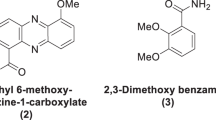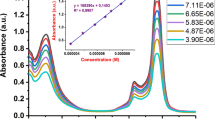Abstract
The antibacterial effect of Zn(II), tetraphenyl porphyrin (TPP), propdioxyl bridged tetraphenyl bisporphyrin 1, and its metallobisporphyrin complexes (ZnMnbisporphyrin 2 and ZnZnbisporphyrin 3) towards Staphylococcus aureus growth was investigated by microcalorimetry at 37°C. Differences in their capacities to inhibit the growth metabolism of S. aureus were observed. By analyzing the power–time curves, crucial parameters such as the rate constant of bacterial growth (k), inhibitory ratio (I), and generation time (t G) were determined. The growth rate constant (k) of S. aureus (in the log phase) in the presence of the drugs decreased linearly with increasing concentrations of the complexes. The sequence of the antibacterial activities of these compounds tested was 3 > 2 > 1 > Zn(II) > TPP. ZnZnbisporphyrin 3 is proposed to benefit from the synergetic effects of Zn(II) and 1.



Similar content being viewed by others
References
Overbye KM, Barrett JF (2005) Antibiotics: where did we go wrong? Drug Discovery Today 10:45–52
Levy SB (2005) Antibiotic resistance—the problem intensifies. Adv Drug Delivery Rev 57:1446–1450
Alanis AJ (2005) Resistance to antibiotics: are we in the post-antibiotic era. Arch Med Res 36:697–705
Chopra I (1998) Research and development of antibacterial agents. Curr Opin Microbiol 1:495–501
Spellberg B, Powers JH, Brass EP, Miller LG, Edwards JE Jr (2004) Trends in antimicrobial drug development: implications for the future. Clin Infect Dis 38:1279–1286
Livermore DM (2005) Minimising antibiotic resistance. Lancet Infect Dis 5:450–459
Soukos NS, Ximenez-Fyvie LA, Hamblin MR, Socransky SS, Hasan T (1998) Targeted antimicrobial photochemotherapy. Antimicrob Agents Chemother 42:2595–2601
Bertoloni G, Lauro FM, Cortella G, Merchat M (2000) Photosensitizing activity of hematoporphyrin on Staphylococcus aureus cells. Biochim Biophys Acta 1475:169–174
Polo L, Segalla A, Bertoloni G, Jori G, Schaffner K, Reddi E (2000) Polylysine–porphycene conjugates as efficient photosensitizers for the inactivation of microbial pathogens. J Photochem Photobiol B Biol 59:152–158
Hamblin MR, O’Donnell DA, Murthy N, Rajagopalan K, Michaud N, Sherwood ME, Hasan TJ (2002) Polycationic photosensitizer conjugates: effects of chain length and Gram classification on the photodynamic inactivation of bacteria. Antimicrob Chemother 49:941–951
Wainwright MJ (1998) Photodynamic antimicrobial chemotherapy (PACT). Antimicrob Chemother 42:13–28
Nakazaki J, Senshu Y, Segawa H (2005) Modulative magnetic interaction in pi-diradicals of directly meso-linked porphyrin dimmers. Polyhedron 24:2538–2543
Chang CK, Abdalmuhdi I (1983) Nucleoside oxazaphospholidines as novel synthons in oligonucleotide synthesis. J Org Chem 48:5388–5389
Harvey PD, Stern C, Gros CP, Guilard R (2007) The photophysics and photochemistry of cofacial free base and metallated bisporphyrins held together by covalent architectures. Coord Chem Rev 251:401–428
Maurya MR, Keith Woo L (2005) Metalloporphyrin as a ligand in organometallic complexes: synthesis and characterization of a nickel(II) porphyrin complex of 1,5-cyclooctadienedichlororuthenium(II). J Organomet Chem 690:4978–4981
Faure S, Stern C, Guilard R, Harvey PD (2005) Synthesis and photophysical properties of meso-substituted dipalladium(II) bisprophyrin; comparative study of phosphorescence quenching by oxygen. Inorg Chem 44:9232–9241
Auld DS (2001) Zinc coordination sphere in biochemical zinc sites. BioMetals 14:271–313
Xie CL, Xu QD, Qu SS (1986) Studies on thermokinetic methods (I) determination of reaction rate constants and activation energies by calorimetry. Acta Physicochimica Sinica 2(4):363–370 (in Chinese)
Hou AX, Liu Y, Huang KW, Xue Z, Qu SS (2003) Microcalorimetric study of the action of two kinds of lanthanide monoporphyinate complexes on growth metabolism of Escherichia coil. Acta Physicochimica Sinica 19(2):134–138 (in Chinese)
Liu Y, Deng FJ, Zhou RM, Shen XS, Wang CX, Qu SS (2000) Microcalorimetric studies of the toxic action of La3+ in mitochondria isolated from star-cross 288 chicken heart tissue cells. Chemsphere 40:851–854
Yan CN, Liu Y, Wang TZ, Tan ZQ, Qu SS, Shen P (1999) Thermochemical studies of the toxic actions of heavy metal ions on Rhizopus nigricans. Chemosphere 38:891–898
Li ZY, Zhang YL, Xie Z, Zhu XJ, Gao ZT, Liu Y (2002) Synthesis of novel metalloporphyrins and their action on the growth metabolism of E. coli. Acta Chimica Sinica 60(5):917–925 (in Chinese)
Zhang LX, Liu Y, Cia LH, Hu YJ, Yin J, Hu PZ (2006) Inhibitory study of some novel Schiff base derivatives on Staphylococcus aureus by microcalorimetry. Thermochim Acta 440:51–56
Yang Y, Liu Y, Zhu J, Li MJ, Shen P (2005) Study on the nucleotide mutation in-35 box sequence of gene promoter by means of microcalorimetric method. J Therm Anal Cal 79:645–648
Chen CQ (2006) Free base porphyrin dimmers and their metalloporphyrin complexes: synthesis and bioassay. M.S. Thesis, Wuhan University, Wuhan, People’s Republic of China
Xie CL, Tang HK, Song ZH, Qu SS, Liao YT, Liu HS (1988) Microcalorimetric study of bacterial growth. Thermochim Acta 123:33–41
Tatini SR, Stein SA, Soo HM (1976) Influence of protein supplements on growth of Staphylococcus aureus and production of enterotoxins. J Food Sci 41:133–135
Acknowledgments
We gratefully acknowledge the financial support of project supported by the National Natural Science Foundation of China (30570015), Creative Scientific Research Group Foundation (NSFC 20621502), Science Research Foundation of Chinese Ministry of Education ([2006]8IRT0543), and Natural Science Foundation of Hubei Province (2005ABC002). We thank the reviewers for their critical comments on the manuscript.
Author information
Authors and Affiliations
Corresponding author
Rights and permissions
About this article
Cite this article
Xu, Xj., Chen, Cq., Wang, Zy. et al. Study of Antibacterial Activity of ZnZnbisporphyrin Complexes and its Free Components on Staphylococcus aureus by Microcalorimetry. Biol Trace Elem Res 127, 269–277 (2009). https://doi.org/10.1007/s12011-008-8243-3
Received:
Accepted:
Published:
Issue Date:
DOI: https://doi.org/10.1007/s12011-008-8243-3




